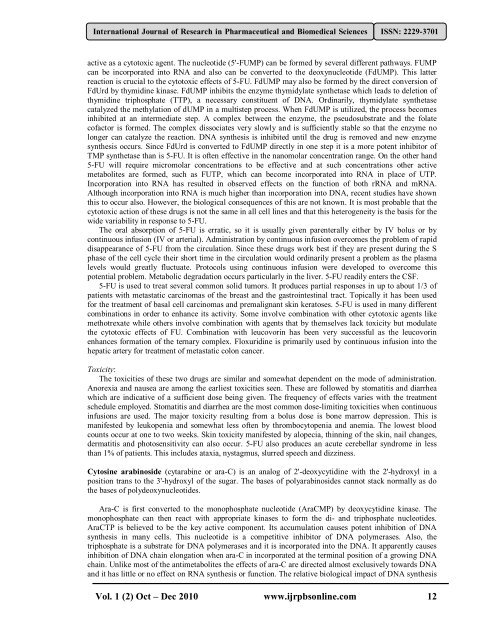Monitoring of Suspected Adverse Drug Reactions in Oncology Unit ...
Monitoring of Suspected Adverse Drug Reactions in Oncology Unit ...
Monitoring of Suspected Adverse Drug Reactions in Oncology Unit ...
You also want an ePaper? Increase the reach of your titles
YUMPU automatically turns print PDFs into web optimized ePapers that Google loves.
International Journal <strong>of</strong> Research <strong>in</strong> Pharmaceutical and Biomedical Sciences ISSN: 2229-3701<br />
active as a cytotoxic agent. The nucleotide (5'-FUMP) can be formed by several different pathways. FUMP<br />
can be <strong>in</strong>corporated <strong>in</strong>to RNA and also can be converted to the deoxynucleotide (FdUMP). This latter<br />
reaction is crucial to the cytotoxic effects <strong>of</strong> 5-FU. FdUMP may also be formed by the direct conversion <strong>of</strong><br />
FdUrd by thymid<strong>in</strong>e k<strong>in</strong>ase. FdUMP <strong>in</strong>hibits the enzyme thymidylate synthetase which leads to deletion <strong>of</strong><br />
thymid<strong>in</strong>e triphosphate (TTP), a necessary constituent <strong>of</strong> DNA. Ord<strong>in</strong>arily, thymidylate synthetase<br />
catalyzed the methylation <strong>of</strong> dUMP <strong>in</strong> a multistep process. When FdUMP is utilized, the process becomes<br />
<strong>in</strong>hibited at an <strong>in</strong>termediate step. A complex between the enzyme, the pseudosubstrate and the folate<br />
c<strong>of</strong>actor is formed. The complex dissociates very slowly and is sufficiently stable so that the enzyme no<br />
longer can catalyze the reaction. DNA synthesis is <strong>in</strong>hibited until the drug is removed and new enzyme<br />
synthesis occurs. S<strong>in</strong>ce FdUrd is converted to FdUMP directly <strong>in</strong> one step it is a more potent <strong>in</strong>hibitor <strong>of</strong><br />
TMP synthetase than is 5-FU. It is <strong>of</strong>ten effective <strong>in</strong> the nanomolar concentration range. On the other hand<br />
5-FU will require micromolar concentrations to be effective and at such concentrations other active<br />
metabolites are formed, such as FUTP, which can become <strong>in</strong>corporated <strong>in</strong>to RNA <strong>in</strong> place <strong>of</strong> UTP.<br />
Incorporation <strong>in</strong>to RNA has resulted <strong>in</strong> observed effects on the function <strong>of</strong> both rRNA and mRNA.<br />
Although <strong>in</strong>corporation <strong>in</strong>to RNA is much higher than <strong>in</strong>corporation <strong>in</strong>to DNA, recent studies have shown<br />
this to occur also. However, the biological consequences <strong>of</strong> this are not known. It is most probable that the<br />
cytotoxic action <strong>of</strong> these drugs is not the same <strong>in</strong> all cell l<strong>in</strong>es and that this heterogeneity is the basis for the<br />
wide variability <strong>in</strong> response to 5-FU.<br />
The oral absorption <strong>of</strong> 5-FU is erratic, so it is usually given parenterally either by IV bolus or by<br />
cont<strong>in</strong>uous <strong>in</strong>fusion (IV or arterial). Adm<strong>in</strong>istration by cont<strong>in</strong>uous <strong>in</strong>fusion overcomes the problem <strong>of</strong> rapid<br />
disappearance <strong>of</strong> 5-FU from the circulation. S<strong>in</strong>ce these drugs work best if they are present dur<strong>in</strong>g the S<br />
phase <strong>of</strong> the cell cycle their short time <strong>in</strong> the circulation would ord<strong>in</strong>arily present a problem as the plasma<br />
levels would greatly fluctuate. Protocols us<strong>in</strong>g cont<strong>in</strong>uous <strong>in</strong>fusion were developed to overcome this<br />
potential problem. Metabolic degradation occurs particularly <strong>in</strong> the liver. 5-FU readily enters the CSF.<br />
5-FU is used to treat several common solid tumors. It produces partial responses <strong>in</strong> up to about 1/3 <strong>of</strong><br />
patients with metastatic carc<strong>in</strong>omas <strong>of</strong> the breast and the gastro<strong>in</strong>test<strong>in</strong>al tract. Topically it has been used<br />
for the treatment <strong>of</strong> basal cell carc<strong>in</strong>omas and premalignant sk<strong>in</strong> keratoses. 5-FU is used <strong>in</strong> many different<br />
comb<strong>in</strong>ations <strong>in</strong> order to enhance its activity. Some <strong>in</strong>volve comb<strong>in</strong>ation with other cytotoxic agents like<br />
methotrexate while others <strong>in</strong>volve comb<strong>in</strong>ation with agents that by themselves lack toxicity but modulate<br />
the cytotoxic effects <strong>of</strong> FU. Comb<strong>in</strong>ation with leucovor<strong>in</strong> has been very successful as the leucovor<strong>in</strong><br />
enhances formation <strong>of</strong> the ternary complex. Floxurid<strong>in</strong>e is primarily used by cont<strong>in</strong>uous <strong>in</strong>fusion <strong>in</strong>to the<br />
hepatic artery for treatment <strong>of</strong> metastatic colon cancer.<br />
Toxicity:<br />
The toxicities <strong>of</strong> these two drugs are similar and somewhat dependent on the mode <strong>of</strong> adm<strong>in</strong>istration.<br />
Anorexia and nausea are among the earliest toxicities seen. These are followed by stomatitis and diarrhea<br />
which are <strong>in</strong>dicative <strong>of</strong> a sufficient dose be<strong>in</strong>g given. The frequency <strong>of</strong> effects varies with the treatment<br />
schedule employed. Stomatitis and diarrhea are the most common dose-limit<strong>in</strong>g toxicities when cont<strong>in</strong>uous<br />
<strong>in</strong>fusions are used. The major toxicity result<strong>in</strong>g from a bolus dose is bone marrow depression. This is<br />
manifested by leukopenia and somewhat less <strong>of</strong>ten by thrombocytopenia and anemia. The lowest blood<br />
counts occur at one to two weeks. Sk<strong>in</strong> toxicity manifested by alopecia, th<strong>in</strong>n<strong>in</strong>g <strong>of</strong> the sk<strong>in</strong>, nail changes,<br />
dermatitis and photosensitivity can also occur. 5-FU also produces an acute cerebellar syndrome <strong>in</strong> less<br />
than 1% <strong>of</strong> patients. This <strong>in</strong>cludes ataxia, nystagmus, slurred speech and dizz<strong>in</strong>ess.<br />
Cytos<strong>in</strong>e arab<strong>in</strong>oside (cytarab<strong>in</strong>e or ara-C) is an analog <strong>of</strong> 2'-deoxycytid<strong>in</strong>e with the 2'-hydroxyl <strong>in</strong> a<br />
position trans to the 3'-hydroxyl <strong>of</strong> the sugar. The bases <strong>of</strong> polyarab<strong>in</strong>osides cannot stack normally as do<br />
the bases <strong>of</strong> polydeoxynucleotides.<br />
Ara-C is first converted to the monophosphate nucleotide (AraCMP) by deoxycytid<strong>in</strong>e k<strong>in</strong>ase. The<br />
monophosphate can then react with appropriate k<strong>in</strong>ases to form the di- and triphosphate nucleotides.<br />
AraCTP is believed to be the key active component. Its accumulation causes potent <strong>in</strong>hibition <strong>of</strong> DNA<br />
synthesis <strong>in</strong> many cells. This nucleotide is a competitive <strong>in</strong>hibitor <strong>of</strong> DNA polymerases. Also, the<br />
triphosphate is a substrate for DNA polymerases and it is <strong>in</strong>corporated <strong>in</strong>to the DNA. It apparently causes<br />
<strong>in</strong>hibition <strong>of</strong> DNA cha<strong>in</strong> elongation when ara-C <strong>in</strong> <strong>in</strong>corporated at the term<strong>in</strong>al position <strong>of</strong> a grow<strong>in</strong>g DNA<br />
cha<strong>in</strong>. Unlike most <strong>of</strong> the antimetabolites the effects <strong>of</strong> ara-C are directed almost exclusively towards DNA<br />
and it has little or no effect on RNA synthesis or function. The relative biological impact <strong>of</strong> DNA synthesis<br />
Vol. 1 (2) Oct – Dec 2010 www.ijrpbsonl<strong>in</strong>e.com 12

















